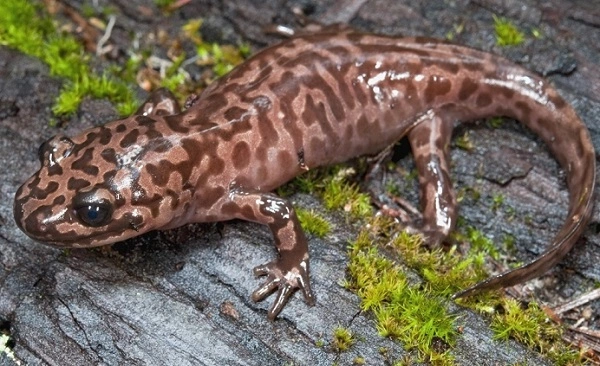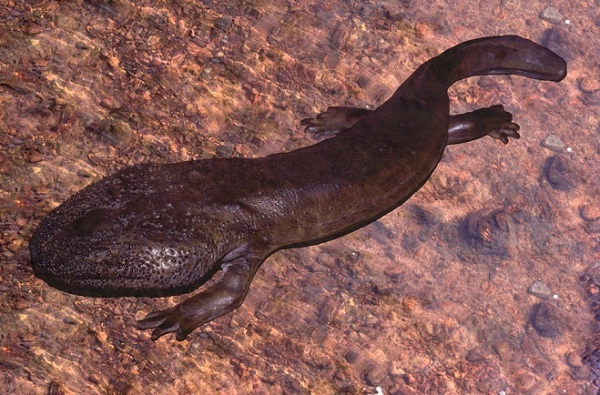The giant salamander is one of the most peculiar creatures in the animal kingdom. It is the world’s largest amphibian and can weigh up to 80 pounds! Despite their size, giant salamanders are shy and generally avoid human contact. This post will provide an in-depth look at these fascinating animals, from their behavior and ecology to their conservation status. So, if you’re curious about giant salamanders, keep reading!

Giant Salamander Description
The Giant Salamander is a large aquatic creature that can grow up to five feet in length. It is found in the waters of North America and Asia and is most commonly seen in the Great Lakes region. The Giant Salamander is a carnivore, and its diet consists primarily of fish, amphibians, and invertebrates. It is an excellent swimmer and uses its powerful tail to propel itself through the water. The Giant Salamander is a shy creature and is rarely seen by humans. However, it is an important part of the ecosystem and plays a vital role in the food chain.
Giant Salamander Habitat
The Giant Salamander is a large amphibian that can be found in North America and parts of Asia. In North America, they are most commonly found in the Appalachian mountains and the Great Smoky Mountains. Giant Salamanders typically live in areas with plenty of moisture, such as near streams, lakes, and rivers. They are also commonly found in forests, where there is ample shade and shelter. Giant Salamanders typically eat small insects and invertebrates. However, they have been known to occasionally eat small mammals, reptiles, and fish. Giant Salamanders play an important role in their ecosystem by helping to control the populations of their prey items. They are also an important food source for many predators, such as snakes, turtles, and birds of prey. Giant Salamanders typically have a lifespan of 20-30 years. however, there has been one documented case of a Giant Salamander living to the age of 50 years.
Giant Salamander Diet
Giant Salamanders are primarily carnivores, feeding on a variety of small animals including insects, worms, snails, and even fish and frogs. While they will readily eat carrion, Giant Salamanders will also actively hunt their prey. When prey is scarce, Giant Salamanders are known to cannibalize smaller members of their own species. Giant Salamanders have extremely poor eyesight and primarily rely on smell and touch to locate food. When hunting, they will often lie in wait near likely sources of prey before striking with sudden speed and ferocity. Giant Salamanders are usually solitary creatures, only coming together to mate. After mating, the female Giant Salamander will lay a large number of eggs which she will then guard until they hatch. The Giant Salamander is a fascinating creature that plays an important role in its ecosystem. As top predators, they help to keep populations of smaller animals in check and their efficient foraging helps to keep forests clean and healthy.

Giant Salamander Size
Giant salamanders are among the largest amphibians in the world, with some species reaching lengths of over 1.5 meters. They are well- adapted to life in water, with webbed feet and paddle-like tails that help them swim. Giant salamanders also have thick, mucus-covered skin that helps to keep them moist and protect them from predators. Some species of giant salamander are also capable of regenerating lost body parts, such as tails and limbs. Giant salamanders typically live in cool, damp environments, such as woodlands and caves near streams or lakes. They are mostly nocturnal creatures, spending much of their time hidden away during the day. Giant salamanders usually hunt at night, preying on small mammals, reptiles, fish, and insects. Although they are slow on land, giant salamanders are excellent swimmers and can make sudden, lunging attacks to capture their prey. Giant salamanders are found throughout the Northern Hemisphere, including North America, Europe, Asia, and Africa.
Giant Salamander Lifespan
Giant Salamanders are some of the longest-lived amphibians, with a lifespan of up to 50 years in captivity. In the wild, Giant Salamanders can live for over 30 years. The Giant Salamander is a slow-growing species, taking up to 8 years to reach full size. Giant Salamanders are believed to reach sexual maturity at around 10 years old. Females lay anywhere from 10 to 100 eggs per clutch, and the eggs take 6 to 12 weeks to hatch. Giant Salamanders are predators, feeding on fish, frogs, and small mammals. They are also cannibalistic, and will sometimes eat other Giant Salamanders. Giant Salamanders are a threatened species due to habitat loss and over-exploitation for the pet trade. In recent years, there has been an increasing demand for Giant Salamanders in traditional Chinese medicine. As a result of this demand, wild populations of Giant Salamanders have been declining.
Giant Salamander Behavior
Giant Salamanders are a type of amphibian that can grow to be over 6 feet long. They are typically found in mountain streams and lakes in Asia, although they can also be found in North America. Giant Salamanders are carnivorous animals, and their diet consists mostly of fish, insects, and other small aquatic creatures. Giant Salamanders are generally shy and reclusive animals, but they can become aggressive if they feel threatened. When mating, Giant Salamanders engage in a courtship ritual that involves the male rubbing the belly of the female with his snout. The female Giant Salamander will then lay her eggs in a secluded spot, and the male will stay with her to protect the eggs until they hatch. After hatching, the Giant Salamander larvae will go through a metamorphosis process in which they transform into adult salamanders. Giant Salamanders can live for up to 50 years in captivity, although their lifespan is thought to be shorter in the wild.
Giant Salamander Speed
Giant salamanders are among the largest amphibians in the world, and they are also known for their relatively high speed. When moving on land, giant salamanders can reach speeds of up to 4.5 meters per second. This is significantly faster than the average human walking speed, which is only about 1 meter per second. Giant salamanders achieve this speed by using their long bodies to undulate their way forward. In water, giant salamanders can swim even faster, reaching speeds of up to 8 meters per second. While this may not seem like much, it is actually quite fast for an amphibian. Giant salamanders are also known for their agile movements, making them difficult to catch. So, if you ever find yourself in the presence of a giant salamander, be sure to give it a wide berth!
Giant Salamander Hunting
Giant Salamanders are large, predatory amphibians that can grow up to six feet in length. They are native to the forests of Asia, and their diet consists mostly of small mammals, reptiles, and fish. In recent years, Giant Salamanders have become a popular hunting target due to their impressive size and their high value on the black market. Giant Salamanders are typically caught with baited traps or by spearing them with a sharpened stick. Once caught, the Giant Salamander is usually killed with a blow to the head or by being cut open along the belly. The meat of the Giant Salamander is then sold to restaurants or individuals who prize it for its taste and medicinal properties.
Conclusion
The giant salamander is an interesting creature that deserves more attention. This amphibian has a long history and may hold the key to understanding how some animals can regenerate their limbs. With its large size and distinctive features, the giant salamander is sure to capture people’s interest. We hope you’ve enjoyed learning about this unique animal and encourage you to do further research on your own. What did you find most surprising about the giant salamander?
Frequently Asked Question

